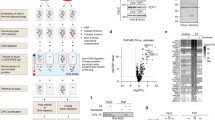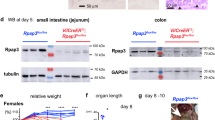Abstract
Peutz–Jeghers syndrome (PJS) is an autosomal dominant disorder characterized by the presence of multiple gastrointestinal polyps and an increased risk for various types of cancers. Inactivating germline mutations of the LKB1 gene, which encodes a serine/threonine kinase, are responsible for the majority of PJS cases. Here, we show that the heteromeric complex containing the molecular chaperones Hsp90 and Cdc37/p50 interacts with the kinase domain of LKB1. Treatment of cells with either geldanamycin or novobiocin, two pharmacological inhibitors of Hsp90 causes the destabilization of LKB1. Furthermore, geldanamycin treatment leads to the ubiquitination and the rapid degradation of LKB1 by the proteasome-dependent pathway. In addition, we found that a LKB1 point mutation identified in a sporadic testicular cancer, weakens the interaction of LKB1 with both Hsp90 and Cdc37/p50 and enhances its sensitivity to the destabilizing effect of geldanamycin. Collectively, our results demonstrate that the Hsp90/Cdc37 complex is a major regulator of the stability of the LKB1 tumor suppressor. Furthermore, these data draw attention to the possible adverse consequences of antitumor drugs that target Hsp90, such as antibiotics related to geldanamycin, which could disrupt LKB1 function and promote the development of polyps and carcinomatous lesions.
This is a preview of subscription content, access via your institution
Access options
Subscribe to this journal
Receive 50 print issues and online access
$259.00 per year
only $5.18 per issue
Buy this article
- Purchase on Springer Link
- Instant access to full article PDF
Prices may be subject to local taxes which are calculated during checkout







Similar content being viewed by others
References
Avizienyte E, Loukola A, Roth S, Hemminki A, Tarkkanen M, Salovaara R, Arola J, Butzow R, Husgafvel-Pursiainen K, Kokkola A, Jarvinen H and Aaltonen LA . (1999). Am. J. Pathol., 154, 677–681.
Baas AF, Boudeau J, Sapkota GP, Smit L, Medema R, Morrice NA, Alessi DR and Clevers HC . (2003). EMBO J., 22, 3062–3072.
Ballinger CA, Connell P, Wu Y, Hu Z, Thompson LJ, Yin LY and Patterson C . (1999). Mol. Cell. Biol., 19, 4535–4545.
Bardeesy N, Sinha M, Hezel AF, Signoretti S, Hathaway NA, Sharpless NE, Loda M, Carrasco DR and DePinho RA . (2002). Nature, 419, 162–167.
Blumer JB, Bernard ML, Peterson YK, Nezu J, Chung P, Dunican DJ, Knoblich JA and Lanier SM . (2003). J. Biol. Chem., 278, 23217–23220.
Boudeau J, Deak M, Lawlor MA, Morrice NA and Alessi DR . (2002). Biochem. J., 19, 849–857.
Ciechanover A and Schwartz AL . (1998). Proc. Natl. Acad. Sci. USA, 95, 2727–2730.
Collins SP, Reoma JL, Gamm DM and Uhler MD . (2000). Biochem. J., 345 (Part 3), 673–680.
Connell P, Ballinger CA, Jiang J, Wu Y, Thompson LJ, Hohfeld J and Patterson C . (2001). Nat. Cell. Biol., 3, 93–96.
Fujita N, Sato S, Ishida A and Tsuruo T . (2002). J. Biol. Chem., 277, 10346–10353.
Giardiello FM, Welsh SB, Hamilton SR, Offerhaus GJ, Gittelsohn AM, Booker SV, Krush AJ, Yardley JH and Luk GD . (1987). N. Engl. J. Med., 316, 1511–1514.
Hemminki A, Markie D, Tomlinson I, Avizienyte E, Roth S, Loukola A, Bignell G, Warren W, Aminoff M, Hoglund P, Jarvinen H, Kristo P, Pelin K, Ridanpaa M, Salovaara R, Toro T, Bodmer W, Olschwang S, Olsen AS, Stratton MR, de la Chapelle A and Aaltonen LA . (1998). Nature, 391, 184–187.
Hunter T and Poon RYC . (1997). Trends Cell. Biol., 7, 157–161.
Jeghers H, McKusick VA and Katz KH . (1949). N. Engl. J. Med., 241, 992–1005.
Jenne DE, Reimann H, Nezu J, Friedel W, Loff S, Jeschke R, Muller O, Back W and Zimmer M . (1998). Nat. Genet., 18, 38–43.
Jiang J, Ballinger CA, Wu Y, Dai Q, Cyr DM, Hohfeld J and Patterson C . (2001). J. Biol. Chem., 276, 42938–42944.
Jishage K, Nezu J, Kawase Y, Iwata T, Watanabe M, Miyoshi A, Ose A, Habu K, Kake T, Kamada N, Ueda O, Kinoshita M, Jenne DE, Shimane M and Suzuki H . (2002). Proc. Natl. Acad. Sci. USA, 99, 8903–8908.
Karuman P, Gozani O, Odze RD, Zhou XC, Zhu H, Shaw R, Brien TP, Bozzuto CD, Ooi D, Cantley LC and Yuan J . (2001). Mol. Cell., 7, 1307–1319.
Kouhara H, Hadari YR, Spivak-Kroizman T, Schilling J, Bar-Sagi D, Lax I and Schlessinger J . (1997). Cell, 89, 693–702.
Liu WK, Chien CY, Chou CK and Su JY . (2003). J. Biomed. Sci., 10, 242–252.
Marcu MG, Chadli A, Bouhouche I, Catelli M and Neckers LM . (2000). J. Biol. Chem., 275, 37181–37186.
Marignani PA, Kanai F and Carpenter CL . (2001). J. Biol. Chem., 276, 32415–32418.
Martin SG and St Johnston D . (2003). Nature, 421, 379–384.
Meacham GC, Patterson C, Zhang W, Younger JM and Cyr DM . (2001). Nat. Cell. Biol., 3, 100–105.
Mehenni H, Gehrig C, Nezu J, Oku A, Shimane M, Rossier C, Guex N, Blouin JL, Scott HS and Antonarakis SE . (1998). Am. J. Hum. Genet., 63, 1641–1650.
Mimnaugh EG, Chavany C and Neckers L . (1996). J. Biol. Chem., 271, 22796–22801.
Miyata Y, Ikawa Y, Shibuya M and Nishida E . (2001). J.Biol. Chem., 276, 21841–21848.
Miyoshi H, Nakau M, Ishikawa TO, Seldin MF, Oshima M and Taketo MM . (2002). Cancer Res., 62, 2261–2266.
Neckers L . (2002). Trends Mol. Med., 8, S55–S61.
Olschwang S, Boisson C and Thomas G . (2001). J. Med. Genet., 38, 356–360.
Pearl LH and Prodromou C . (2000). Curr. Opin. Struct. Biol., 10, 46–51.
Perdew GH, Wiegand H, Vanden Heuvel JP, Mitchell C and Singh SS . (1997). Biochemistry, 36, 3600–3607.
Peutz JL . (1921). Ned. Tijdschr. Geneeska, 10, 134–146.
Prodromou C, Roe SM, O'Brien R, Ladbury JE, Piper PW and Pearl LH . (1997). Cell, 90, 65–75.
Rossi DJ, Ylikorkala A, Korsisaari N, Salovaara R, Luukko K, Launonen V, Henkemeyer M, Ristimaki A, Aaltonen LA and Makela TP . (2002). Proc. Natl. Acad. Sci. USA, 99, 12327–12332.
Sanchez-Cespedes M, Parrella P, Esteller M, Nomoto S, Trink B, Engles JM, Westra WH, Herman JG and Sidransky D . (2002). Cancer Res., 62, 3659–3662.
Sapkota GP, Boudeau J, Deak M, Kieloch A, Morrice N and Alessi DR . (2002). Biochem. J., 362, 481–490.
Sapkota GP, Kieloch A, Lizcano JM, Lain S, Arthur JS, Williams MR, Morrice N, Deak M and Alessi DR . (2001). J. Biol. Chem., 276, 19469–19482.
Schulte TW, Blagosklonny MV, Ingui C and Neckers L . (1995). J. Biol. Chem., 270, 24585–24588.
Shen Z, Wen XF, Lan F, Shen ZZ and Shao ZM . (2002). Clin. Cancer Res., 8, 2085–2090.
Smith DP, Spicer J, Smith A, Swift S and Ashworth A . (1999). Hum. Mol. Genet., 8, 1479–1485.
Smith DP, Rayter SI, Niederlander C, Spicer J, Jones CM and Ashworth A . (2001). Hum. Mol. Genet., 10, 2869–2877.
Spigelman AD, Murday V and Phillips RK . (1989). Gut, 30, 1588–1590.
Stancato LF, Silverstein AM, Owens-Grillo JK, Chow YH, Jove R and Pratt WB . (1997). J. Biol. Chem., 272, 4013–4020.
Stebbins CE, Russo AA, Schneider C, Rosen N, Hartl FU and Pavletich NP . (1997). Cell, 89, 239–250.
Su J-Y, Erikson E and Mailer JL . (1996). J. Biol. Chem., 271, 14430–14437.
Tiainen M, Vaahtomeri K, Ylikorkala A and Makela TP . (2002). Hum. Mol. Genet., 11, 1497–1504.
Tiainen M, Ylikorkala A and Makela TP . (1999). Proc. Natl. Acad. Sci USA, 96, 9248–9251.
Toft DO . (1999). Control of Hormone Receptor Function by Molecular Chaperones and Folding Catalysts. Academic Publishers, Harwood, Amsterdam.
Watts JL, Morton DG, Bestman J and Kemphues KJ . (2000). Development, 127, 1467–1475.
Whitesell L, Mimnaugh EG, De Costa B, Myers CE and Neckers LM . (1994). Proc. Natl. Acad. Sci. USA, 91, 8324–8328.
Whitesell L, Sutphin P, An WG, Schulte T, Blagosklonny MV and Neckers L . (1997). Oncogene, 14, 2809–2816.
Ylikorkala A, Avizienyte E, Tomlinson IP, Tiainen M, Roth S, Loukola A, Hemminki A, Johansson M, Sistonen P, Markie D, Neale K, Phillips R, Zauber P, Twama T, Sampson J, Jarvinen H, Makela TP and Aaltonen LA . (1999). Hum. Mol. Genet., 8, 45–51.
Ylikorkala A, Rossi DJ, Korsisaari N, Luukko K, Alitalo K, Henkemeyer M and Makela TP . (2001). Science, 293, 1323–1326.
Young JC, Moarefi I and Hartl FU . (2001). J. Cell Biol., 154, 267–273.
Acknowledgements
We gratefully acknowledge Janet Hall for critical reading of the manuscript. We also thank Dirk Bohmann for the kind gift of the plasmid expressing HA-tagged ubiquitin. This work was supported by the Ligue Nationale Contre le Cancer (group Marc Billaud ‘labellisée’ by the Ligue Nationale Contre le Cancer). During this work, PN, HG and MR have been the recipients of a fellowship from the Ligue Nationale Contre le Cancer, Comité de Haute-Savoie and Ligue Nationale and from the Fondation pour la Recherche Médicale, respectively.
Author information
Authors and Affiliations
Corresponding author
Rights and permissions
About this article
Cite this article
Nony, P., Gaude, H., Rossel, M. et al. Stability of the Peutz–Jeghers syndrome kinase LKB1 requires its binding to the molecular chaperones Hsp90/Cdc37. Oncogene 22, 9165–9175 (2003). https://doi.org/10.1038/sj.onc.1207179
Received:
Revised:
Accepted:
Published:
Issue Date:
DOI: https://doi.org/10.1038/sj.onc.1207179
Keywords
This article is cited by
-
Tankyrase disrupts metabolic homeostasis and promotes tumorigenesis by inhibiting LKB1-AMPK signalling
Nature Communications (2019)
-
Controlling the master—upstream regulation of the tumor suppressor LKB1
Oncogene (2018)
-
Combined HSP90 and kinase inhibitor therapy: Insights from The Cancer Genome Atlas
Cell Stress and Chaperones (2015)
-
STRAD pseudokinases regulate axogenesis and LKB1 stability
Neural Development (2014)
-
Molecular chaperone complexes with antagonizing activities regulate stability and activity of the tumor suppressor LKB1
Oncogene (2012)



